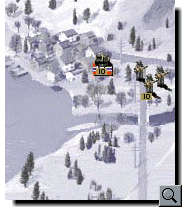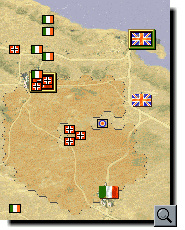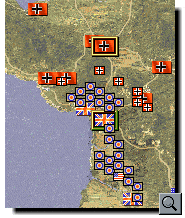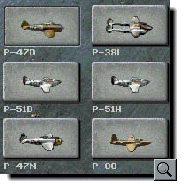 t takes a special brand of individual to be a computer wargaming grognard. First off, one must possess the ability to stare at cryptic orders like "X65-3DGNT" and instantly decipher that an Italian Alpini infantry unit is under heavy fire from mortars across the hill. One needs to master the art of looking cross during moments of intense amusement. Most of all, and perhaps best of all, the right to bear the name "grognard" requires the ability to completely and totally envelop yourself into the skill and art of war. t takes a special brand of individual to be a computer wargaming grognard. First off, one must possess the ability to stare at cryptic orders like "X65-3DGNT" and instantly decipher that an Italian Alpini infantry unit is under heavy fire from mortars across the hill. One needs to master the art of looking cross during moments of intense amusement. Most of all, and perhaps best of all, the right to bear the name "grognard" requires the ability to completely and totally envelop yourself into the skill and art of war.
 Most folks will never achieve grognard status, and for them, Panzer General II should more than satisfy any compulsion to recreate the epic struggles of World War II. As the catalyst used to unveil a new, vastly improved engine in the series, the game wildly exceeds expectations in almost every department.
Most folks will never achieve grognard status, and for them, Panzer General II should more than satisfy any compulsion to recreate the epic struggles of World War II. As the catalyst used to unveil a new, vastly improved engine in the series, the game wildly exceeds expectations in almost every department.
Included in the game are over thirty battles in several campaigns. Unlike the original Panzer General, campaigns are playable from a German, American, British, or Soviet perspective. Scenarios range from the usual battles comprising Germany's famous Blitzkrieg to the final days of Berlin during the Soviet offensive. Due to a reduced map scale, the game focuses on key battles in concentrated geographic areas. Not only must players concern themselves with achieving victory, but also prestige (via richer, more full-bodied victories) to keep the momentum going throughout successive battles. A few lukewarm results early in the campaign spell almost certain doom. Resources tend to dry up quickly when the folks at the requisition desk hear you got pasted by Belgian Recon units during the last offensive.
At first glance, it would be so very easy to write off this title as just a glitzy sequel. To a point, that assessment has merit. However, further inspection reveals many subtle improvements and amenities that, when combined, put Panzer General II in the strategy forefront.
 By now, most people expect high quality video and film footage to relay the introduction and mission briefings. Rest assured the game comes complete with those quintessential video vitamins and minerals (and yes, "batteries" are included). What gamers probably won't expect, but will be pleasantly surprised to discover, is the striking photo-realistic quality of the battle maps. Where most strategy games make do with abstract tiles depicting roads, rivers, and other terrain, Panzer General II utilizes sharp, pristine imagery that looks fantastic and feels seamless. It's much easier to visualize a convoy of troops heading up a valley when that valley flows naturally into the adjacent hills and plains, rather than several bite sized chunks of terrain pre-qualified as "valley" fodder. These maps fare very well when compared to actual geographic data denoting the section of the world they represent. Brave souls accustomed to using enlarged aerial photographs on the kitchen floor both to terrify feline entities and reenact war with their plastic army men (tip: pulverized Cheetos make great nerve gas) will find this title good enough to obsolesce at least one of those prior practices.
By now, most people expect high quality video and film footage to relay the introduction and mission briefings. Rest assured the game comes complete with those quintessential video vitamins and minerals (and yes, "batteries" are included). What gamers probably won't expect, but will be pleasantly surprised to discover, is the striking photo-realistic quality of the battle maps. Where most strategy games make do with abstract tiles depicting roads, rivers, and other terrain, Panzer General II utilizes sharp, pristine imagery that looks fantastic and feels seamless. It's much easier to visualize a convoy of troops heading up a valley when that valley flows naturally into the adjacent hills and plains, rather than several bite sized chunks of terrain pre-qualified as "valley" fodder. These maps fare very well when compared to actual geographic data denoting the section of the world they represent. Brave souls accustomed to using enlarged aerial photographs on the kitchen floor both to terrify feline entities and reenact war with their plastic army men (tip: pulverized Cheetos make great nerve gas) will find this title good enough to obsolesce at least one of those prior practices.
In conjunction with improved maps, animation of the individual units underwent considerable improvement. Each unit moves as one would expect: infantry goose-steps, tanks rumble across the landscapes (even facing the direction they're traveling now), and aircraft sputter along their intended flight plan. In keeping the focus on war and tactics, most of the glitz remains subdued enough that players won't feel bogged down by wait times while the same explosion routine runs its course for the umpteenth time. Beyond the eye candy, SSI did extensive work to distinguish similar units (a PzIVg compared to a PzIVF2, for example) on paper as well as visually.
 For Panzer General II, SSI puts on a clinic in respects to its manual. With brief descriptions of campaigns and battles, a complete and informative guideline of general game operations, and an exhaustive set of tables breaking down every unit from every country, the manual deserves special recognition. Hopefully, other companies will take note and upgrade their current manual design staffs with breathing members of society.
For Panzer General II, SSI puts on a clinic in respects to its manual. With brief descriptions of campaigns and battles, a complete and informative guideline of general game operations, and an exhaustive set of tables breaking down every unit from every country, the manual deserves special recognition. Hopefully, other companies will take note and upgrade their current manual design staffs with breathing members of society.
Numerous additions to movement and firing rules add welcome functionality to the inane scheme used in the original. Many of these new features were included because, quite simply, they make perfect sense. Units now move or fire in either order during a turn. Thankfully, players may move several units, then initiate fire with all of them. The newly introduced Recon class units ignore zones of control. Tanks possess overrun capabilities, lending them opportunities to steamroller several hapless infantry grunts in a single turn. Certain troop types even benefit from phased movement, allowing short hops rather than one giant leap per turn. By themselves, these features may appear minuscule, but the added allowances for movement and troop behavior garner a huge impact on the ease of coordinating assaults.
Say goodbye to the "buddy system," where artillery and supporting fire were forced to sidle right up to adjacent hexes of friendly forces. Ranges now vary from one to four hexes, and artillery can offer support from anywhere within their range. Tanks fire across several hexes if their line of sight isn't impeded by terrain. The claustrophobic scale of battle has eliminated strategic bombing; however, tactical bombers now provide the same turn-long suppression.
 The most noteworthy addition involves the use of leader abilities. Officially, units who've been subjected to the harsh realities of war may spawn stout leaders with certain unique abilities borne of their tempering in battle. Unofficially, after a unit gains a hundred points (up to level five), the hidden pair of fuzzy dice inside your computer get rolled. If you win, the unit snags a special ability. Lose, and the fuzzy dice get munched by the power supply fan. Keep a broom handy.
The most noteworthy addition involves the use of leader abilities. Officially, units who've been subjected to the harsh realities of war may spawn stout leaders with certain unique abilities borne of their tempering in battle. Unofficially, after a unit gains a hundred points (up to level five), the hidden pair of fuzzy dice inside your computer get rolled. If you win, the unit snags a special ability. Lose, and the fuzzy dice get munched by the power supply fan. Keep a broom handy.
The lengthy list of available advantages include higher movement allowances, entrenchment modifiers, back issues of Mad magazine to distract enemy troops weak in the Force, and even the ability to fire twice per turn. It's safe to say the game achieves greater replayability in that no two campaigns are truly alike. Grognards beware: adding this miniature role playing feature destroys any notion of technical accuracy (unless you believe in the shrapnel fairy), as suddenly Colonel Klink could quite possibly defeat General Rommel thanks to his newfound "Chinese Checkers Mastery" ability. Great for fans, bad news for fanatics, so to speak.
 Not only does the AI appear more intelligent than before, it also seems to give itself a normal amount of prestige. You no longer find yourself in the unrealistic position of having to fight a more experienced army in the rear areas after destroying the "elite forces" on the enemy front lines. Beyond solo play, the game maintains a firm commitment to multiplayer, offering modem, network, and PBEM possibilities. To further reinforce replayability, a fairly comprehensive scenario editor allows the creation of individual battles, historical or wacky.
Not only does the AI appear more intelligent than before, it also seems to give itself a normal amount of prestige. You no longer find yourself in the unrealistic position of having to fight a more experienced army in the rear areas after destroying the "elite forces" on the enemy front lines. Beyond solo play, the game maintains a firm commitment to multiplayer, offering modem, network, and PBEM possibilities. To further reinforce replayability, a fairly comprehensive scenario editor allows the creation of individual battles, historical or wacky.
Don't worry, hard core wargamers. You can pull those old gripes about the original out of the attic, dust them off with a lint free cloth to avoid scratches, and they'll be just as applicable to Panzer General II. Plenty of room still exists for improvement, particularly to an interface which seems to have taken a lover's leap backwards.
Beyond intermittent technical glitches experienced on several machines, the main map view displays a smaller portion of the entire map than before. This could probably be chalked up to a narcissistic ploy to show off the tremendously detailed maps. Unfortunately, it forces players to toggle between the strategic and tactical maps too frequently. As well, the maps still seem as overexposed and washed out as a low shutter speed photograph taken of the sun.
 Unit information comes at a premium. The game departs from the original one click information scheme into the treacherous "Carrot and Click" routine, requiring four clicks to finally get comprehensive information on a selected unit. Battle updates shoot on and off the screen like flash cards for Attention Deficit Disorder sufferers. Even details as basic as the weather now require additional scavenging through the menus to obtain. Worst of all, no easy method exists for determining composite sight ranges of your units. Welcome back to the thriving world of counting hexes (don't forget those hidden leader bonuses for sighting, either). The option to retain the Panzer General interface would have been a welcome, welcome sight.
Unit information comes at a premium. The game departs from the original one click information scheme into the treacherous "Carrot and Click" routine, requiring four clicks to finally get comprehensive information on a selected unit. Battle updates shoot on and off the screen like flash cards for Attention Deficit Disorder sufferers. Even details as basic as the weather now require additional scavenging through the menus to obtain. Worst of all, no easy method exists for determining composite sight ranges of your units. Welcome back to the thriving world of counting hexes (don't forget those hidden leader bonuses for sighting, either). The option to retain the Panzer General interface would have been a welcome, welcome sight.
Still, Panzer General II shows tremendous, yet strangely silent, improvement. Any mainstream gamer with a passive interest in the simple mechanics of war won't feel disappointed. Veterans of the original will enjoy the newfound freedom to truly position and coordinate troops realistically. Grognards should be ecstatic to hear what they were only going to believe anyway: that though there's more for them to love, there's just as much for them to hate. All told, the game offers solid value and longevity, even if Tanya isn't around to dash across the map blowing away armored divisions with a single shot of her .45. Disappointing, I'm sure, but sometimes sacrifices just have to be made.
Requirements:
- Windows 95
- 90 MHz Pentium or higher
- 16 MB RAM
- 4X CD-ROM
Multiplayer: 2-4 players, Internet, LAN, play-by-e-mail
|
